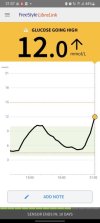Hi all,
I have a quick question about corrections. I'm working out that my ratio is around one unit of insulin for 3 Mmols but its not always accurate. I sometimes over correct especially in the evenings. Can I ask if for example in this case where I'm at 12 and going up, would you correct by one unit to bring it from 12 to nine or would I assume that since I'm going up it would be 15 so I should correct by 2 units. Im aiming for good numbers but find thay i under dose ans then over dose to corect. Its a balance trying to avoid hypos and high numbers. Thanks
I have a quick question about corrections. I'm working out that my ratio is around one unit of insulin for 3 Mmols but its not always accurate. I sometimes over correct especially in the evenings. Can I ask if for example in this case where I'm at 12 and going up, would you correct by one unit to bring it from 12 to nine or would I assume that since I'm going up it would be 15 so I should correct by 2 units. Im aiming for good numbers but find thay i under dose ans then over dose to corect. Its a balance trying to avoid hypos and high numbers. Thanks

